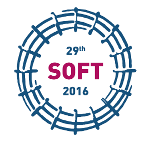Speaker
Suk-Kwon Kim
(Nuclear Fusion Engineering Development Division)
Description
The Developments of plasma facing components (PFCs) are the key items for the nuclear fusion reactors. The most components for the tokamak PFCs are the blanket first wall, divertor, heating ports, and diagnostics ports. These PFCs are composed of the armour materials, the heat sink for the cooling, and the structural materials. Be, W, C-composites, and advanced materials were selected for these armour in the case of the ITER and DEMO concepts. For the development of these plasma facing components, small test mockups are fabricated and tested in a high heat flux test facility to evaluate the thermal life cycles. The high heat flux facility for these performance tests in Korea, KoHLT-EB (Korea Heat Load Test Facility-Electron Beam) has been operated by KAERI (Korea Atomic Energy Research Institute). The beam power is a 300 kW with the electron gun and mid-frequency power supply, and the allowable target area is 70 cm x 50 cm. For the high heat load test of PFCs, small mockups were fabricated by various bonding techniques. Tungsten armour mockups were 1) W and FMS HIP bonding, 2) W coating in FMS structural materials up to 3 mm, 3) W and Cu bonding, and 4) 3D metal printing cooling structure. Each fabricated mockup was installed inside KoHLT-EB, and thermo-hydraulic tests and thermal fatigue tests were performed to qualify the mockups specification and bonding techniques.
Co-authors
Dong Won Lee
(Nuclear Fusion Engineering Development Division, Korea Atomic Energy Research Institute, Daejeon, South Korea)
Eo Hwak Lee
(Nuclear Fusion Engineering Development Division, Korea Atomic Energy Research Institute, Daejeon, South Korea)
Hyung Gon Jin
(Nuclear Fusion Engineering Development Division, Korea Atomic Energy Research Institute, Daejeon, South Korea)
Jae-Sung Yoon
(Nuclear Fusion Engineering Development Division, Korea Atomic Energy Research Institute, Daejeon, South Korea)
Seong Dae Park
(Nuclear Fusion Engineering Development Division, Korea Atomic Energy Research Institute, Daejeon, South Korea)
Seungyon Cho
(ITER Korea, National Fusion Research Institute, Daejeon, South Korea)
Suk-Kwon Kim
(Nuclear Fusion Engineering Development Division, Korea Atomic Energy Research Institute, Daejeon, South Korea)

